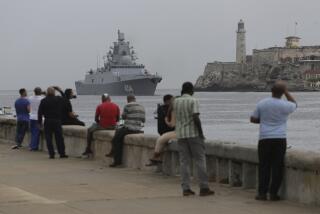New Look at Missile Crisis
- Share via
There are a few points left out of the article by Bernstein on the Cuban missile crisis. Bernstein claims that “the missiles in Cuba did not tip the strategic balance against the United States” because the overall missile count still favored the United States, and because the Cuban missiles could not reach U.S. intercontinental ballistic missile silos. In fact, the Cuban missiles were a substantial advantage to the Soviet Union.
Missiles launched from the Soviet Union take approximately 30 minutes to reach the United States. This allows some time to assess the situation, attempt to contact Moscow, and, if necessary, launch a counterattack. The Soviet Union has the same reaction-time safeguard. Missiles launched from Cuba cut this reaction time to about 5 minutes. In addition, while the U.S. ICBMs were out of range, the major cities of the Eastern Seaboard, including Washington, were not. These factors would allow the Soviet Union to destroy the U.S. seat of government, and then, in the ensuing confusion, launch a preemptive attack on U.S. missile sites. With such a short amount of time to react, the United States could either do nothing, or launch a counterattack at the first warning of a possible attack from Cuba, thus heightening the possibility of a nuclear war beginning by accident.
By using selected facts, Bernstein chides Kennedy for preferring confrontation to statesmanship. However, for some reason, he has chosen to ignore the Soviet Union’s responsibility for the crisis. The attempt to install nuclear weapons 90 miles from our coast demonstrates that it was the Soviet Union that sought confrontation.
DANIEL J. HALEY
Culver City
More to Read
Sign up for Essential California
The most important California stories and recommendations in your inbox every morning.
You may occasionally receive promotional content from the Los Angeles Times.










